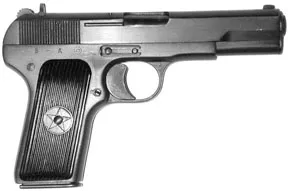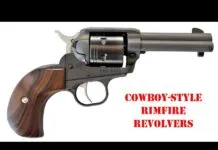
Fourteen hundred feet per second from a pistol in 1930? Make that 1896! In the late 1800s Hugo Borchardt designed a pistol, and a cartridge for it, that became the Model 1893 Borchardt pistol. Borchardt was an American, but his pistols were made by Loewe in Germany. (The Borchardt pistol evolved into the Luger pistol, which used a shorter, less-powerful .30-cal. cartridge.) A hotter loading of Borchardt’s cartridge was adopted by Mauser for his 1896 pistol, known as the “broomhandle.” Velocity was in the 1,400 fps realm, and it was the fastest handgun cartridge around for many years.
In 1930, Fedor V. Tokarev developed a near-identical, bottle-neck 7.62 x 25 cartridge for a pistol of his design, which was adopted by the Soviets as their official handgun and cartridge in 1930, designated the TT-30. Tokarev successfully packaged a very-high-speed .30-caliber cartridge into a reasonable-sized, handy, lightweight pistol that put the odd-looking “broomhandle” Mauser to ergonomic shame. The Tokarev was significantly more powerful than the .30 Luger of 1900. In case you’re wondering, TT stands for Tula Tokarev, Tula being the arsenal where the TT-30 was produced. In 1933 the gun design was slightly altered, and became the TT-33.
The Tokarev design was a modification of the long-proven Browning 1911-type design, the most notable change being a subassembly that contains the hammer, sear, disconnector, and their related springs in one easily removable unit. The TT-33 was adopted by the Chinese as their Type 51, by the Hungarians as the 7.62 Model 48, and by several other countries. It was made at least until the end of WWII, and is commonly encountered within what used to be the Soviet Bloc. The cartridge is quite similar to the .30 Mauser, and some sources say the Mauser cartridge can be fired in the Tokarev (but we don’t recommend it). Velocity of the Tokarev is 1,400 fps, nearly twice as fast as some .45 Auto loads.
The bullets measure 0.306- to 0.308-inch diameter, and weigh about 85 grains. Reloading should be easy, but surplus ammunition is cheap right now, priced around 12 cents a shot when bought by the case, so you don’t have to reload to get a whole lot of shooting fun out of one of these pistols.
We acquired three pistols for this interesting cartridge, Polish and Chinese versions of the TT-33 ($180 each), and a sample of the more recent and interesting Czech Model 52, $150. Neither of the Soviet-made versions, TT-30 or TT-33, had a safety lever. Both our Polish and Chinese versions did, but they were two entirely different systems. We were told the Chinese pistols had safety levers added so they could be imported.
The TT-33 design was also used to make a .22 LR version of this pistol, called the R-3, for training purposes, and also a .22-cal. target version called the R-4, with abbreviated slide and extended barrel. Here’s what we found when we tested these guns:
Chinese Model 54-1 7.62x25mm, about $180
Although our sources indicated the Chinese version of the TT-33 was called the Model 51, ours was marked Model 54-1. However, the designation markings on our test gun were Western, not Chinese. The inscription on the slide said, among other things, “Made in China by Norinco.”
The gun appeared to be new. Its finish was apparently wire brushed, and then blued for a matte effect. Grips were black plastic, with a five-pointed star within a circle on each. The barrel was blued, and was like new inside. The fit and finish were somewhat on the rough side, though the gun worked perfectly well. The hammer, which stuck up above the slide on this design, was well serrated for good control. The trigger broke at 5.5 pounds, and was clean. Sights were an integral blade front and a dovetailed, U-notch rear. The sight picture lacked enough light around the front blade, a condition which is easy to fix by filing the rear notch wider. The front blade was not perfectly parallel with the slide, which gave a fuzzy sight picture. That also could be fixed with a file, though care would have to be taken to avoid marring the slide.
It was not possible to put the safety on and chamber a round. The safety, an apparent afterthought on the left-rear side of the frame, blocked the hammer. If the safety was on, the slide could not be drawn back to depress the hammer, unlike the situation with the Polish version of this gun, tested below. The Chinese safety had two detent holes, but the lever was loose, and flopped wherever it wanted to throughout our testing. If it could be made positive, the gun could maybe be used for cocked-and-locked carry because it was relatively easy to take the safety off with the thumb as the gun was grasped.
On both this Chinese and the Polish version, the slide stayed open after the last shot. After inserting a fresh 8-shot magazine, the slide of either gun could be closed like a 1911 auto, by depressing the slide stop. (This was not the case with the Czech 52, tested below.) The magazine was removed by depressing a button behind the left side of the trigger. On inserting a new magazine, we found it necessary to take care to avoid pinching the hand between the frame and the new mag. On both the Chinese and Polish TT-33, the magazine was reluctant to drop free from the gun when the slide was locked open. But with the slide closed, the mags flew out under spring pressure, a good-enough reason to be sure to reload before you run the gun dry.
[PDFCAP(2)]The first few five-shot groups fired with the Model 54-1 were complete disasters, measuring around nine inches at 15 yards. However, things quickly got better, and most later groups were around three inches. The gun was still slightly stiff when we finished our test shooting, and we believe it could give better accuracy as things wear in. Also, the sights were a handicap. We had the gun on loan, so didn’t mess with the sight picture.
Polish TT-33, about $180
When the Polish TT-33 arrived, it was filled with heavy grease, which meant the gun required complete disassembly. Takedown was similar to the 1911 (and identical with the Chinese version tested above), involving rotating the barrel bushing (180 degrees). We later found takedown to be easier if we left the barrel bushing alone, slipped the split retainer off the barrel-lug pin and removed that pin, then slid the slide forward off the frame, being careful to contain the compressed recoil spring within the slide until we could carefully remove it. The magazine also was designed for easy disassembly.
The metal beneath the grease was well machined and finished, and nicely blued. The importer, Southern Ohio Gun, said these Polish pistols were new, and we don’t doubt it. The barrel was white on the outside, and looked like new on the inside. The locking lugs within the slide showed signs of having been tested for hardness, a sure indicator that the maker cared enough to test the product before shipping it.
The grips were black plastic. The left panel had a raised thumb rest that interfered slightly with the trigger finger of lefties. The Chinese version of this pistol did not have a thumb rest. The Polish TT-33 and its magazine both had lanyard rings. The ring on the frame was on the left side, which would interfere with southpaws if they wanted to use a lanyard as a steady rest. Removal of the grip panels involved inserting a screwdriver into the magazine well and sliding a clip on the left panel rearward, permitting the panel to be removed from the frame. The right side was then accessible for similar removal. The grips were well made and fit the gun snugly.
When we cleaned the Polish gun, we found all its major parts were numbered, and all but the magazine matched the serial number. We found rust within the hole in the hammer that holds its spring. The spring was slightly bent, and we noted that the hammer had noticeably less spring tension than either of the other two pistols.
The Polish TT-33 had a crisp trigger pull, which broke at 5.3 pounds. Its sights consisted of a dovetailed, U-notched rear and a small, narrow blade at the front. The front blade appeared to be integral with the slide. Although the sight picture was more delicate than we’d have liked, it was superior to that of the Chinese gun, on which we had trouble getting a clear sight picture. We would have preferred a wider front blade and a wider rear notch for faster sight acquisition.
The safety was a small lever beneath the slide lock, located where it was possible to take it off by shoving it down with the thumb. When we first tried it, the safety was very stiff, but it loosened up during our testing. The fit and finish of the safety didn’t match the rest of the gun, so it may have been added after the gun was made. It blocked the trigger, and that appeared to be all it did.
Some of our shooting team got their hands bitten by the hammer. The same shooters didn’t get bit by the near-identical Chinese version. Comparison showed a little more steel beneath the hammer of the Chinese gun, enough to force the web of the hand out of danger.
On the range we found the Polish TT-33 didn’t always fire the old surplus cartridges. We went back inside the gun and stretched the hammer spring from a length of 1.3 inches to 1.5, and that helped, but was not enough to make the gun totally reliable with the surplus ammo. We switched the entire firing block with the Chinese-made version and that cured the problem. When we had the Chinese hammer assembly temporarily installed, we checked the Polish gun for accuracy, but found it made no difference. The Polish TT-33 worked perfectly with the recently made Sellier & Bellot ammo.
Every time the gun fired it fed and cycled properly from its eight-round magazine. The guide rails that were part of the hammer/sear assembly did a great job of directing the rounds into the chamber, and of course the bottleneck shape helped. Ejection was very positive. It took us a long time to find the first few empty cases. This round gives a sharp and loud report, and we got every bit of 1,400 fps out of all three types of ammo.
Czech 52, about $150
Although we were not all that excited when we first saw this single-action pistol, we changed our minds when we looked inside. The Czech 52 turned out to be far more interesting than the Tokarev pistols. At first glance its finish was rough, its grips were stuck on with a spring clip, and the gun was bigger and heavier than the T33 for the same cartridge. However, the CZ 52 was designed for a more potent loading of the same cartridge. When we took apart the CZ 52, we were flat amazed.
When we disassembled the pistol for pre-shooting inspection, we were at first confused, then totally awe-struck by it. It was roller locked! It used a design borrowed from the German MG42 of WWII, one of the better machine guns ever made. If you have any background whatsoever in machining, or can appreciate complex, precise metal working, by all means get yourself one of these. The first time you take the slide off the frame—which is accomplished by pulling downward on the two lugs in front of the trigger and shoving the slide about a quarter-inch forward—you’ll get your money’s worth just by admiring the fascinating and complex machining that goes into one of these high-intensity pistols. Such an intricate firearm design will almost certainly never be copied any time soon. The cost for the machine work would drive the price of the Czech 52 to astronomical levels today.
There are myriad parts, all carefully made, and that’s just what you can see on the frame. Beneath the clipped-on grips are other surprises, like a nut securing the hammer pin in place, and opposite that, a hairpin spring that presses against the slide-stop lever. Look inside the grip area and you’ll discover the hammer spring does double duty on the magazine retainer. The CZ 52 was an exceptional design, much more robust than appeared necessary for the T30 cartridge. There were good reasons for that, as we discovered.
Inside the slide the barrel was held firmly in place by its surrounding recoil spring. We could see the bottoms of the two rollers, locked into the cutouts in the side of the slide. A push against the back of the barrel showed how the rollers came out of engagement with the slide, and then were driven back into them by a cam when we released pressure on the barrel.
A hole in the bottom of the barrel lug was put there to permit removal of the barrel. We did that by inserting a screwdriver into the hole and forcing the barrel forward far enough so that the barrel and spring could be withdrawn downward, out of the slide. If you try this at home, the spring will be under a good deal of compression, and care must be used to avoid injury or flying parts. With the barrel removed, the simple yet very effective locking rollers may be examined, or removed if needed by driving a small pin sideways. We saw no reason to take the rollers out, and with the barrel cleaned, we put the gun back together for further inspection.
The exterior of our test gun was entirely ho-hum. The machining was roughly, though not carelessly, done. There had not been much time spent putting on a fancy finish, inside or out. The metal was protected by what looked like dark gray Parkerizing. The grips, of a composite material that resembled bakelite, were just a tiny bit loose. They were held to the gun by a spring clip that encircled them at the back, and by notches molded into their front portion. We have seen sources for walnut replacements, though they would greatly increase the cost of the package. The grips were serrated, and gave a good-enough grasp on the gun.
The CZ 52 had a three-position safety lever. All the way down was Fire, and in that position a red dot was uncovered. We noted, during one firing string, that the trigger was getting progressively harder to pull. The gun finally refused to fire, and we found the safety lever had been slowly forced upward by our thumb with each shot. There is a detent on the safety when it is fully in the Fire position, and we had not put the lever all the way down, so the fault was ours. It never happened again. When the lever was moved upward to cover the red dot, it was not possible to fire the gun. Yet the slide could be cycled, so you could unload the chamber of a cocked gun with some degree of safety. Also, the hammer could be locked before chambering a round. Pushing the safety lever farther upward caused the hammer to fall, but the hammer could not strike the firing pin. The safety was positioned similar to that of the 1911, and permitted almost easy operation, which would lend the gun to cocked-and-locked carry. Within the slide, the firing pin was restrained from going forward until the trigger was nearly fully back, yet another safety feature on this cleverly designed pistol.
The sights consisted of a thin integral blade machined into the front of the slide, and a driftable rear, with U-notch. We would have liked a fatter front blade and appropriately wider rear, but the sight picture was okay. The point of impact at 15 yards was about an inch higher than the point of aim, well centered. The trigger pull was just over five pounds. The trigger blade was curved to fit the finger, which made the pull feel lighter than it was. The hammer was well serrated to ease cocking. The magazine was retained by a lever at the bottom of the grip, a bad location if fast reloads are on your schedule. There was a lanyard ring just behind the safety catch.
So we had a roller-locked, intricately machined handgun with a lot of engineering inside of it. How well would it shoot? Our first few five-shot groups measured just under three inches, and the gun stayed pretty much in that ballpark throughout our testing. The CZ 52 was not new when we got it, but didn’t appear to have been shot a lot. Its barrel was in excellent condition inside. The slide was not tightly fitted to the frame. We suspect many of the tricks that make 1911s shoot better would help any of our test trio shoot better. We believe this sort of accuracy experimentation would be a lot of fun for the home gunsmith, especially considering the low cost of these pistols and their ammunition.
The magazine held eight rounds, and was easy to load. During our shooting tests, the first thing we noticed was the slight shifting of the grips on the gun when we grasped it firmly. That could be fixed with a tiny bit of epoxy or even some tape in the right place, if it offends you. The second thing was that the trigger hurt our firing finger on recoil. The bottom edge of the curved trigger was sharper than it needed to be. A few minutes with a file would fix that. We found the CZ 52 got about 50 fps more out of all three types of ammo tested than either of the TT-33 copies.
The next thing we noticed was that the slide didn’t stay open after the last shot, as it should have. Inspection revealed the pin around which the thin slide stop rotated was coming out of the frame, and the slide stop was being bent outward so it could not pivot. Its pin had the appearance of having been staked in place during original manufacture, but was now loose. We fixed it easily by restaking it with a center punch. A more elegant fix would be to install a bulkier aftermarket slide stop, which again would add a big percentage to the modest cost of the pistol, but might be well worth it because such a lever permits closing the slide with the thumb. As the gun was designed, it is necessary to withdraw the locked-back slide slightly and let it fly home to chamber a round. Some folks report the firing pin of the CZ 52 is fragile, so we recommend that you do not dry fire the gun. (Lots of parts for the CZ 52, including walnut grips and several redesigns of the firing pin, were offered for sale at http://makarov.com/cart/vitemcz52.htm. We particularly noticed barrels in 9 x 19mm, which are supposed to instantly alter this pistol to a 9mm.)
The gun fed, fired, and ejected properly and never missed a beat. Because this gun was heavier than the other two, felt recoil was a bit less than with the Tokarev design, and that’ll help if you happen to acquire some of the original Czech ammunition for this one. We told you this gun was stoutly built, and locked up like a fortress. We also told you the 7.62×25 cartridge zinged its bullets out at 1,400 fps. Well, partner, the original Czech loading for the CZ 52 achieved over 1,600 fps! The weight and bulk of the CZ 52 would compare favorably with most 9mm handguns. The bulk of the CZ 52 was less than that of a 1911-type .45 auto. We know there are better handguns available today for self-defense (all of them more costly), but suspect that this gun would be more than satisfactory for that purpose. If you have to use the CZ 52 and 7.62×25 ammo for protection, we believe the combination is a lot better than some of the most modern solutions.
Gun Tests Recommends
Chinese Model 54-1, $180. Conditional Buy. We thought the Chinese Tokarev was worth having, being both a practical fun gun and inexpensive. It was also a good representative pistol of the Chinese way of making a Tokarev, and hence historically important. We would not use this particular pistol for self-defense, because of potential problems with the loose safety. It worked perfectly, and its only flaw was the loose safety lever, which was not part of the original design. However, for the same money you can get the Polish version, which had better fit, finish and accuracy.
Polish TT-33, $180. Buy It. This pistol had excellent accuracy, was well made, nicely fitted and finished, and was a good piece of history as well. We would replace the hammer spring, and call it good. For the price, the gun offered lots of power and cheap shooting with surplus ammo, and because the gun was light in weight it would do well enough for carry purposes. We would enlarge the safety button if we were going to carry this gun, and would probably seek out soft-nose ammunition for self-defense. Some might not like the sharp grip angle, but modern shooters who know what to do with the weak hand will have no problems with this one. In spite of the possibly weak hammer spring we thought this pistol to be well worth the little trouble involved in replacing it, if you chose to. You may have to have a custom spring made, or instead may choose to shoot only S&B ammo with it.
CZ 52, $150. Our Pick. The CZ 52 was a very worthwhile and useful handgun. It was one of the most interesting pistols we’ve seen from design and manufacturing standpoints. It would do for home defense, would do very well for fun shooting, and would do exceptionally well for anyone remotely interested in firearms design, in our view.





























